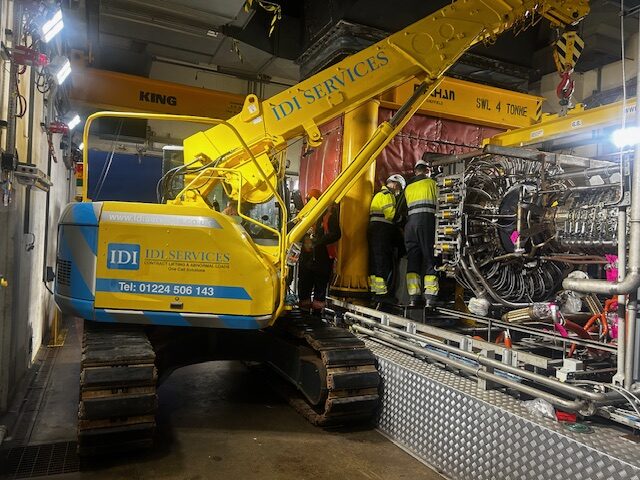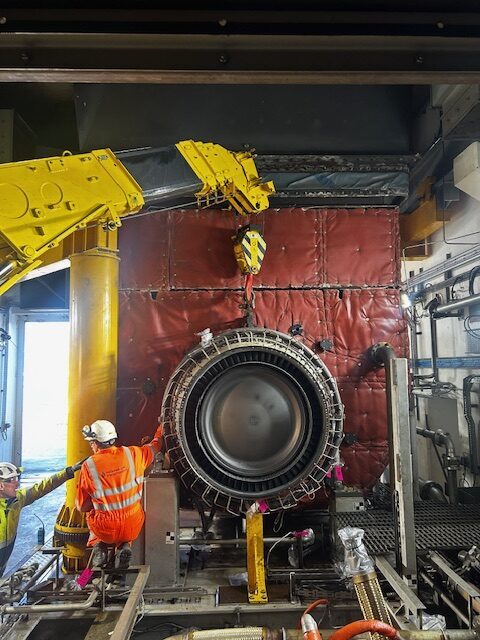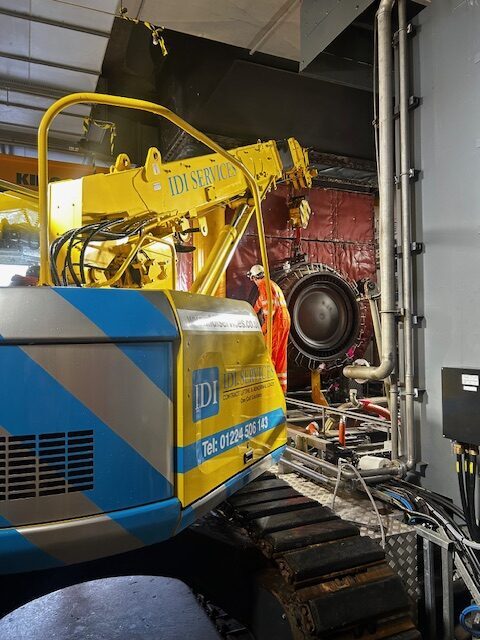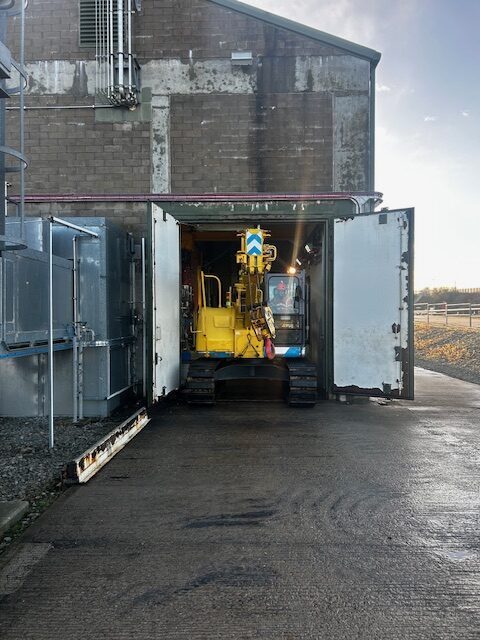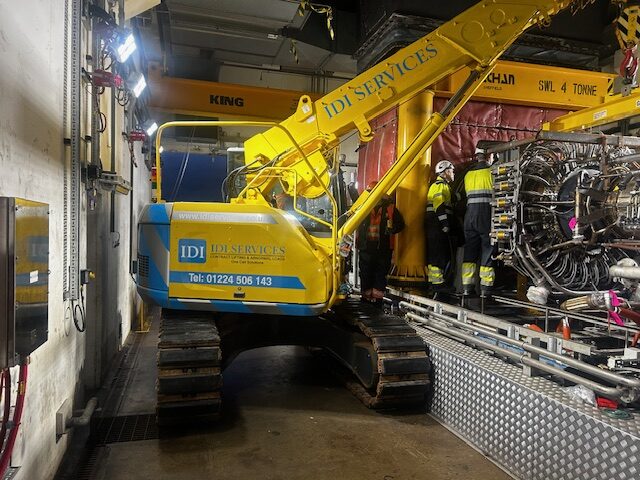
CASE STUDY: Critical Infrastructure Equipment Replacement
IDI Services Delivers Compact Crane Excellence for National Gas Turbine Replacement
Client Profile
National Gas (formerly National Grid Gas Transmission), the owner and operator of Great Britain’s high-pressure gas transmission network, required the replacement of a gas-powered turbine at one of their critical infrastructure facilities. As the organization responsible for transporting gas safely and reliably to homes, businesses, and power stations across Britain, National Gas operates complex facilities housing essential equipment within purpose-built enclosures. The turbine replacement demanded a lifting partner with specialized compact crane capabilities—equipment that could physically access the severely confined industrial space where conventional cranes simply cannot operate—combined with the technical expertise and security clearance necessary for working within critical national infrastructure.
The Challenge
The National Gas turbine replacement presented challenges that perfectly demonstrate why specialized compact crane equipment is essential for critical infrastructure projects:
Absolute Access Impossibility for Conventional Equipment
- Conventional mobile cranes physically cannot access the turbine housing—building design, doorway dimensions, and internal space constraints make standard lifting equipment completely unsuitable.
- Turbine located within purpose-built enclosure designed for operational efficiency, not equipment replacement access.
- Standard industrial doorways preventing any conventional crane entry to the facility interior.
- Confined working space within turbine housing with extremely limited clearances around equipment.
- Multi-storey industrial structure with turbine positioned deep within building configuration.
- This project could not be completed without specialized compact crane equipment.
Critical Infrastructure Environment
- Active gas transmission facility requiring absolute reliability and zero disruption to national energy infrastructure.
- Security protocols and clearance requirements for personnel working within critical national infrastructure.
- Operational continuity paramount with turbine replacement timed to minimize system impact.
- Coordination with National Gas operations team regarding facility isolation and equipment preparation.
- Safety-critical environment with stringent protocols protecting personnel, equipment, and infrastructure.
- Heritage of reliable service to National Gas requiring proven capabilities and professional execution.
Turbine Specifications and Handling Requirements
- Gas-powered turbine representing substantial investment and critical operational component.
- Heavy industrial equipment weighing several tonnes requiring appropriate lifting capacity despite confined space.
- Complex geometry with circular turbine housing and associated mechanical components visible in operations.
- Precision engineering demanding careful handling to prevent damage to turbine components and systems.
- Sequential removal and installation operations requiring turbine extraction and replacement unit positioning.
- Connection points and mounting interfaces requiring millimetre-accurate alignment for proper installation.
Confined Space Technical Demands
- Severely restricted working envelope with turbine housing designed around operational requirements, not maintenance access.
- Overhead clearances, wall proximities, and equipment density creating extremely challenging lifting environment.
- Limited manoeuvring space requiring compact equipment with exceptional control capabilities.
- Floor loading considerations within industrial facility ensuring structural capacity for equipment operations.
- Coordination with facility systems including electrical, mechanical, and control infrastructure throughout operations.
- Protection requirements for surrounding equipment, instrumentation, and facility infrastructure.
The IDI Services Solution: Compact Crane Essential Capability
This project exemplifies exactly why IDI Services maintains two specialized compact cranes—situations where conventional lifting equipment is physically incapable of accessing the work location:
Why Only Compact Cranes Could Work
Absolute Access Requirement:
- Standard mobile cranes cannot enter industrial facilities through normal doorways—physically impossible due to width, height, and configuration.
- External cranes cannot reach turbines located deep within multi-storey industrial buildings.
- Facility design optimized for operations, not equipment replacement, creating permanent access barriers for conventional equipment.
- The compact crane’s ability to navigate standard doorways and operate in confined spaces was not merely advantageous—it was absolutely essential.
The Compact Crane Solution:
- IDI Services’ compact tracked crane navigated standard industrial doorway entering the turbine housing interior visible in project imagery.
- Low overall height allowed operation beneath building ceiling structures and overhead services.
- Tracked undercarriage provided stability whilst distributing load across industrial flooring.
- Articulated boom configuration enabled precise positioning within severely confined working envelope.
- Without specialized compact crane equipment, this critical infrastructure project could not have proceeded.
Phase 1: Critical Infrastructure Planning and Security Protocols
Our team conducted comprehensive planning recognizing the unique demands of critical national infrastructure:
- Security clearance procedures ensuring all personnel met National Gas requirements for critical infrastructure access.
- Detailed facility assessment documenting turbine housing configuration, access routes, working clearances, and structural considerations.
- Engineering evaluation of turbine specifications including weight, dimensions, lifting points, and handling sensitivities.
- Coordination with National Gas operations team establishing isolation procedures, operational windows, and communication protocols.
- Load calculations and structural assessments ensuring industrial facility could accommodate compact crane operations.
- Development of comprehensive method statements and risk assessments specific to critical infrastructure environments and gas industry facilities.
- Emergency response planning addressing facility-specific protocols and National Gas operational requirements.
- Access route verification confirming compact crane could navigate from facility entrance to turbine housing interior.
Phase 2: Facility Access and Confined Space Setup
The project commenced with equipment deployment to this critical infrastructure location:
Critical Infrastructure Entry:
- Security procedures and facility induction ensuring full compliance with National Gas protocols.
- Compact crane transport to facility and positioning for building entry.
- Navigation of standard industrial doorways that would prevent any conventional crane access—visible in exterior project imagery.
- Careful movement through facility corridors and access routes with comprehensive protection of infrastructure and systems.
- Entry into turbine housing interior positioning compact crane in severely confined working space.
Confined Space Equipment Positioning:
- Compact crane positioning within turbine housing adjacent to gas-powered turbine requiring replacement.
- Outrigger deployment in extremely confined space utilizing compact footprint for operational stability.
- Assessment of overhead clearances beneath building ceiling and services ensuring safe boom operation.
- Verification of working envelope around turbine confirming ability to execute required lifting operations.
- Final safety briefings with National Gas personnel and IDI Services team establishing communication protocols.
Phase 3: Existing Turbine Removal Operations
The first critical phase involved extraction of the operational turbine:
Turbine Disconnection and Preparation:
- Coordination with National Gas engineers regarding turbine isolation, disconnection, and preparation for removal.
- Verification of lifting point accessibility and rigging equipment suitability for turbine configuration.
- Assessment of removal trajectory navigating turbine through confined space to facility exit.
- Final pre-lift inspections of rigging equipment, compact crane systems, and surrounding environment.
Precision Turbine Extraction:
- Controlled lifting of existing gas-powered turbine using specialized rigging designed for turbine geometry.
- Careful manoeuvring through severely confined turbine housing navigating around facility infrastructure and systems.
- Articulated boom operation precisely positioning load avoiding contact with building structure, overhead services, and adjacent equipment.
- Continuous monitoring of clearances ensuring safe passage through restricted spaces.
- Controlled movement from turbine housing through facility corridors to exterior for removal.
- Professional execution protecting both the extracted turbine and all facility infrastructure throughout operations.
Phase 4: Replacement Turbine Installation
The critical installation phase achieved precision positioning within the confined industrial space:
Replacement Unit Introduction:
- Rigging of replacement gas-powered turbine at facility exterior using appropriate lifting equipment.
- Controlled movement through facility access routes navigating standard doorways and corridors.
- Entry into turbine housing interior managing load trajectory through confined passages.
- Precision positioning approaching turbine mounting location within severely restricted working envelope.
Millimetre-Accurate Installation:
- Controlled lift positioning replacement turbine at mounting interface within turbine housing.
- Articulated boom operation allowing complex load movements impossible with conventional straight-boom cranes.
- Incremental adjustments under National Gas engineers’ guidance achieving perfect alignment with mounting points and connection interfaces.
- Millimetre-accurate placement ensuring proper turbine positioning for mechanical connections, electrical interfaces, and operational requirements.
- Temporary support whilst National Gas team completed connection procedures and securing operations.
- Final verification confirming turbine positioned correctly for commissioning and operational service.
Phase 5: Project Completion and Infrastructure Handover
- Systematic demobilization of compact crane from turbine housing interior.
- Controlled egress through facility corridors and exit via standard doorways.
- Complete removal of rigging equipment and restoration of turbine housing to operational configuration.
- Final inspection confirming zero damage to facility infrastructure, systems, or equipment throughout operations.
- Comprehensive documentation and handover to National Gas operations team.
- Critical infrastructure returned to operational readiness with replacement turbine installed.
The Results
The National Gas turbine replacement delivered exceptional outcomes demonstrating compact crane essential capabilities:
Access Achievement—The Absolute Requirement
- Successful operation within turbine housing where conventional cranes physically cannot access.
- Project completion entirely dependent on compact crane’s unique capability to navigate standard doorways and operate in confined spaces.
- Zero compromise to facility infrastructure—no building modifications, doorway enlargements, or structural alterations required.
- Full lifting capability maintained despite severely confined working environment.
- Demonstration of equipment that solved an impossible access challenge for critical infrastructure.
Critical Infrastructure Performance
- Zero safety incidents throughout all operations within active gas transmission facility.
- Full security compliance meeting National Gas requirements for critical infrastructure access and operations.
- Zero disruption to facility operations beyond planned turbine replacement window.
- Complete infrastructure protection with no damage to facility systems, equipment, or building structure.
- Professional execution maintaining standards expected for critical national infrastructure projects.
Operational Excellence
- Precision turbine positioning achieving exact alignment for mechanical and electrical connections.
- Successful confined space operations demonstrating exceptional control in severely restricted working envelope.
- On-time completion meeting National Gas operational schedule and facility availability window.
- Zero damage to turbines, facility equipment, or surrounding infrastructure throughout all operations.
- Seamless coordination with National Gas operations team throughout planning and execution.
Technical Achievement
- Complex load trajectories executed using articulated boom configuration in confined multi-obstacle environment.
- Millimetre-accurate positioning of heavy industrial equipment within severely restricted space.
- Structural preservation achieving all objectives whilst protecting irreplaceable facility infrastructure.
- Professional integration with National Gas protocols, systems, and operational requirements.
Client Partnership Success
- Trusted capability for critical infrastructure projects requiring absolute reliability.
- Security clearance enabling work within sensitive national facilities.
- Proven expertise reinforcing IDI Services’ position supporting Britain’s energy infrastructure.
- Repeat business foundation demonstrating reliability for future National Gas projects.
Client Testimonial
“IDI Services’ compact crane capabilities are essential for our turbine replacement operations at facilities where conventional lifting equipment simply cannot access the working locations. Their specialized equipment enabled us to replace critical turbines within our confined facility spaces without requiring building modifications that would be prohibitively expensive and operationally disruptive. The team’s understanding of critical infrastructure requirements, security protocols, and the absolute necessity of zero-incident operations exemplifies the professionalism we require for work within our facilities. IDI Services has proven to be a trusted partner for projects where access challenges would defeat conventional approaches.”
— Operations Manager, National Gas
The IDI Advantage: Critical Infrastructure Compact Crane Specialization
This project exemplifies IDI Services’ unique capabilities serving Britain’s critical infrastructure sectors:
When Conventional Equipment Cannot Access
Critical Infrastructure Facility Challenges: Power stations, gas transmission facilities, water treatment plants, and telecommunications centres feature purpose-built enclosures housing essential equipment. These facilities present:
- Doorways sized for personnel and operational access, not large equipment replacement.
- Multi-storey buildings with equipment positioned deep within interior spaces.
- Confined working envelopes optimized for operations, not maintenance access.
- Building structures that cannot be easily modified without substantial cost and operational disruption.
- Equipment requiring periodic replacement despite access constraints inherent to facility design.
Conventional Crane Impossibility: Standard mobile cranes, even smaller models, cannot:
- Pass through standard industrial doorways—physically too wide, too tall, or both.
- Reach equipment located within building interiors beyond external crane radius.
- Operate beneath low ceilings and restricted overhead clearances typical of industrial facilities.
- Navigate confined spaces between equipment, systems, and infrastructure.
- Function without building modifications that would compromise facility operations and security.
The Compact Crane Essential Solution: IDI Services’ two specialized compact cranes provide:
- Physical access through standard doorways and into facility interiors where conventional equipment cannot reach.
- Confined space operation within severely restricted working envelopes around critical equipment.
- Full lifting capability despite compact dimensions—suitable for turbines, transformers, and industrial components.
- Articulated boom precision enabling load trajectories impossible for conventional equipment in confined spaces.
- Infrastructure-compatible operations requiring no building modifications or structural alterations.
Critical Infrastructure Sector Experience
Energy Infrastructure Support: IDI Services serves Britain’s energy sector with specialized compact crane capabilities:
- Gas transmission facilities including compressor stations and distribution centres.
- Power generation facilities requiring turbine, generator, and transformer maintenance.
- Electrical substations and distribution infrastructure projects.
- Renewable energy facilities including wind farms and biomass plants.
- Emergency response for critical equipment failures requiring immediate replacement.
National Infrastructure Clients: Established relationships with major infrastructure operators:
- National Gas (gas transmission network operations).
- Power generation companies across conventional and renewable sectors.
- Water utilities requiring equipment replacement at treatment facilities.
- Telecommunications providers maintaining network infrastructure.
- Transport infrastructure organizations managing critical facilities.
Security and Compliance: Meeting the stringent requirements of critical infrastructure projects:
- Security clearance procedures for personnel accessing sensitive facilities.
- Comprehensive understanding of operational continuity requirements.
- Zero-incident culture essential for critical infrastructure environments.
- Full regulatory compliance meeting sector-specific standards and protocols.
Two Compact Cranes—Strategic Capability Investment
Why IDI Services Maintains Dual Compact Crane Fleet:
- Availability ensuring specialized capabilities accessible when critical infrastructure projects require them.
- Backup capacity for situations where equipment availability directly affects national infrastructure operations.
- Rapid deployment responding to emergency situations and urgent replacement requirements.
- Competitive advantage providing capabilities unavailable from conventional crane operators.
- Proven essential for projects where building access constraints make conventional equipment physically impossible to use.
Critical Infrastructure Dependence: Working within Britain’s energy, water, telecommunications, and transport infrastructure has repeatedly demonstrated:
- Compact cranes are often the only viable solution for equipment replacement in existing facilities.
- Building modifications to accommodate conventional equipment are prohibitively expensive and operationally disruptive.
- Critical infrastructure operators depend on specialized capabilities for maintaining aging facilities.
- National Gas and other infrastructure organizations require partners with proven compact crane expertise.
Critical Infrastructure Equipment Replacement
Britain’s energy, water, telecommunications, and transport infrastructure depends on complex equipment housed within purpose-built facilities designed decades ago. Turbines, transformers, generators, pumps, and control systems require periodic replacement as technology advances and components reach end-of-life. Yet these facilities feature access constraints that make equipment replacement extraordinarily challenging using conventional methods.
The National Gas turbine replacement exemplifies this reality. A critical gas-powered turbine requiring replacement within a facility where conventional mobile cranes physically cannot access the equipment location. Building modifications to accommodate standard lifting equipment would be prohibitively expensive, operationally disruptive, and potentially compromise facility security and integrity.
IDI Services’ compact crane provided the essential solution—equipment specifically designed to navigate standard doorways, operate in confined spaces, and deliver full lifting capability despite compact dimensions. From facility entry through turbine extraction and replacement unit installation, the project demonstrated capabilities that conventional approaches simply cannot provide.
This specialized equipment represents vital capability for Britain’s infrastructure operators. National Gas, power generation companies, water utilities, and telecommunications providers all depend on compact crane expertise for maintaining facilities where conventional equipment access is impossible.
IDI Services’ two compact cranes, comprehensive critical infrastructure experience, security clearances, and proven zero-incident performance position us as the trusted partner for equipment replacement projects throughout Britain’s essential infrastructure networks.
Whether your project involves turbine replacements, transformer installations, generator maintenance, or any critical infrastructure equipment requiring lifting capabilities within confined facility spaces, IDI Services delivers the specialized compact crane equipment, technical expertise, security compliance, and operational excellence that Britain’s critical infrastructure depends on.
For more information on how IDI Services’ compact crane capabilities can support your critical infrastructure projects, contact our team today.

